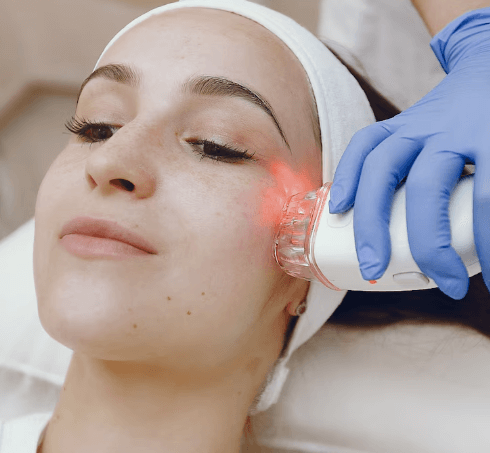Treatment Overview
UltraClear Laser is a new-generation cold ablative fiber laser technology that is increasingly used in Korean dermatology for pigmentation, acne scars, skin resurfacing, and congenital birthmark treatment.
Unlike traditional ablative lasers like CO₂, UltraClear uses a cold laser fiber system that minimizes collateral heat damage while still creating micro-ablation zones to target pigmented lesions and stimulate regeneration. This makes it suitable for flat, superficial, and some dermal pigmented birthmarks, especially in Asian skin where post-inflammatory hyperpigmentation (PIH) risk is higher.
Korean dermatologists often use UltraClear as a stand-alone therapy for superficial pigmented lesions or in combination with Pico or Alexandrite lasers for deeper congenital birthmarks.
Purpose & Benefits
- Birthmark Removal: Helps lighten or remove superficial and some dermal pigmented lesions.
- Safer Than Traditional Ablation: Cold laser reduces heat damage, lowering PIH risk.
- Skin Renewal: Improves texture, tone, and stimulates collagen.
- Faster Healing: Compared to CO₂, downtime is shorter.
- Combination-Friendly: Can be paired with Pico/Nd:YAG for complex birthmarks.
Ideal Candidates
UltraClear Laser in Korea is recommended for:
- Patients with flat pigmented birthmarks (café-au-lait spots, light congenital nevi).
- Individuals with superficial pigmentation + texture issues.
- Patients prone to PIH who cannot tolerate traditional CO₂ lasers.
- Adults wanting dual benefit: pigment clearance and rejuvenation.
Possible Risks & Complications
UltraClear is designed to minimize risks, but side effects may include:
- Redness & Mild Swelling: Common, lasts 1–3 days.
- Dryness & Flaking: Natural skin renewal.
- Temporary Darkening: Pigment may darken before fading.
- Rare Risks: PIH rebound, infection, or scarring (much lower risk than CO₂).
Surgical Techniques Used
- Cold Fiber Ablative Mode: Removes pigmented cells with minimal thermal spread.
- Fractional Mode: Creates microchannels for faster healing and deeper pigment clearance.
- Combination Protocols: Often integrated with Pico or Alexandrite for stubborn birthmarks.
Protocol: Usually 3–5 sessions, spaced 4–6 weeks apart, depending on depth and size of lesion.
Recovery & Aftercare
Immediately: Redness, warmth, and mild sensitivity.
2–5 Days: Dryness, flaking, or micro-crusting.
1–2 Weeks: Birthmark appears lighter; skin looks smoother.
Aftercare Tips:
- Use SPF 50+ sunscreen daily to prevent PIH.
- Apply soothing and hydrating creams.
- Avoid peeling or scratching scabs.
- Skip exfoliants, acids, and retinoids for 5–7 days.
Results & Longevity
- After 1 Session: Fresher tone, mild pigment fading.
- After 2–3 Sessions: Noticeable lightening of superficial birthmarks.
- After 3–5 Sessions: Significant clearance of flat pigmented lesions.
- Long-Term: Results are often permanent for many superficial marks; deeper lesions may require combined therapies.
Treatment Process in Korea
Consultation & Skin Analysis
- Dermatologist evaluates lesion type (superficial vs. deep congenital).
- UltraClear chosen if flat or epidermal-dominant pigment.
Preparation
- Cleansing and numbing cream application.
- Protective eyewear provided.
UltraClear Laser Session
- Step 1: Fractional/cold ablative mode applied to lesion.
- Step 2: Multiple passes may be performed depending on depth.
- Step 3: Cooling mask or antioxidant serum applied.
- Duration: 20–30 minutes.
Post-Treatment Care
- Hydrating creams and sunscreen applied before discharge.
- Mild aftercare restrictions (no harsh skincare for a few days).
Follow-Up
- 3–5 sessions recommended for optimal results.
- Often combined with Pico, Alexandrite, or Fractional RF for resistant cases.
Unique Korean Advantages
- Advanced Cold Laser Technology: Safer for Asian skin with less heat-induced PIH.
- Combination Programs: UltraClear integrated with Pico or boosters for tough cases.
- Faster Healing: Less downtime compared to CO₂ laser resurfacing.
- Affordable Packages: Clinics in Seoul offer cost-effective multi-session bundles.
Cost Range (Estimated)
- Small Lesion (per session): USD 200 – 350
- Medium to Large Area (per session): USD 300 – 600
- 3–5 Session Package: USD 1,000 – 2,200
Additional Costs:
- Consultation: USD 20 – 50
- Add-ons (Whitening drips, Vitamin C/TXA serums): USD 100 – 200
- Boosters (PRP, Rejuran, exosomes): USD 200 – 500
Example Korean Packages:
- Basic UltraClear Birthmark Program (3 sessions): USD 700–900
- Advanced Program (UltraClear + Whitening Drips): USD 1,200–1,600
- Premium Package (UltraClear + Pico/Boosters): USD 2,000–2,800
Popular Clinics in Seoul
- Oracle Dermatology: UltraClear for superficial pigmented lesions.
- Banobagi Dermatology: UltraClear + Pico for congenital pigmented birthmarks.
- Renewme Skin Clinic: UltraClear with whitening serums and boosters.
- View Plastic & Dermatology: UltraClear + Fractional CO₂ for pigment + texture.
- Chaum Anti-Aging Center: Premium UltraClear with regenerative add-ons.




